Hamsters are remarkable creatures and one of the most remarkable things about them is their teeth. Their teeth, like those of many other rodents, are their primary way to defend themselves. However, while most people know a thing or two about hamster teeth, there’s much more to learn than you might think.
Today, we’re going to take a closer look at the teeth of hamsters by going over the 9 most fascinating facts. Let’s dig in!
1. Hamsters have 16 teeth
All hamsters have a total of 16 teeth: 4 incisors and 12 molars. The incisors are located in the front of their mouth and are sharp and long. The bottom incisors are about 2 to 3 times longer than the ones on the top. Incisors are used to grab, slice, and cut food. Molars, on the other hand, are located further back in the mouth and are short and stumpy. They are used to grind down food so that it becomes easier to swallow.
According to the University of Cincinnati, the dental formula for hamsters is 2(I 1/1 C 0/0 PM 0/0 M 3/3), which means that they have 2 upper and 2 lower incisors, no canines, no premolars, and 6 upper and 6 lower molars for a total of 16 teeth
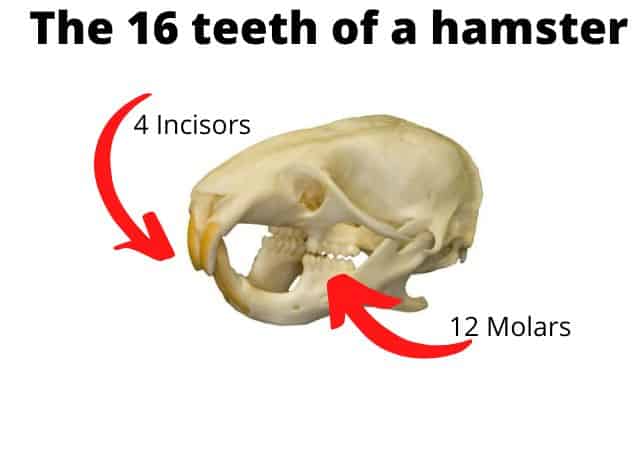
Many people believe that hamsters only have 4 teeth. That’s an easy mistake to make because only the 4 incisors are really easily visible. The 12 molars are so far back in the mouth that they’re almost impossible to spot. However, rest assured that they do indeed have 12 teeth!
An interesting thing to note is that hamsters have molars and incisors because they’re omnivores. Incisors are mainly used to eat animals while molars are mainly used to grind down plant-based foods.
If you’re wondering what healthy, normal hamster teeth should look like, here is an image that you can use as a reference:
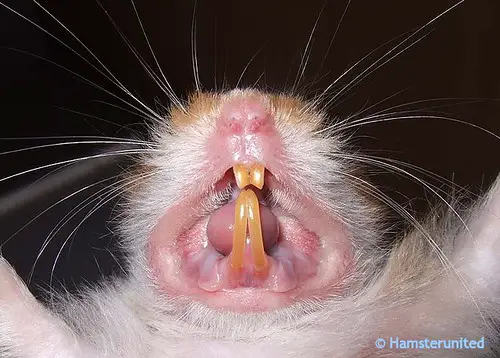
2. Hamsters are born with all their teeth
Unlike humans, baby hamsters are born with all their teeth. They also only have one set of fangs throughout their life. What this means is that they do not go through the teething process.
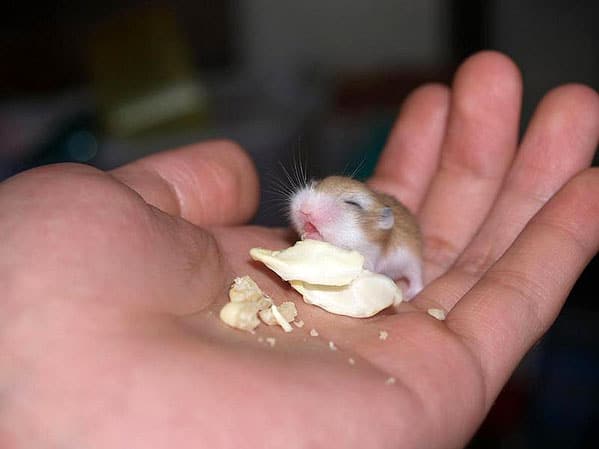
Of course, when they are born their teeth are very small. It wouldn’t be possible to fit the massive teeth of a fully grown hamster in the mouth of a baby! They’re so small that they’re almost invisible, but they’re definitely there.
3. Hamster teeth are naturally yellow in color
For humans, pearly white choppers are a sign of strong healthy teeth. Yellow teeth are not a good sign for us. In hamsters, this is a little bit different. You see, hamsters naturally have yellow teeth, but that’s not because they’re dirty. Instead, they’re yellow because of their enamel, which is a protective layer over their teeth. Their enamel gets its yellow/orange color because it contains a lot of iron, vitamin E, and vitamin A.
So, do not worry about your hamster’s yellow teeth, it’s perfectly normal and healthy. It’s actually the opposite that you should be worried about. If you notice that your hamster’s fangs start to turn white that can mean that they are deficient in vitamin A, E, or iron.
4. Hamster are elodont: their teeth never stop growing
The teeth of hamsters never stop growing. Because of this, it’s very important that hamsters grind down their teeth. They have to do this because otherwise, their teeth become too long for their mouths which can cause trouble eating and result in injury. An interesting thing to note is that only their incisors keep growing, while their molars do not. The reason for this is simple: evolution.
In the wild, hamsters grind down their teeth continuously while eating. They eat a wide range of different foods, many of which are quite hard, such as nuts. These hard foods result in their incisors being ground down all the time. If their incisors did not keep growing at all times they would eventually just have stumps left for incisors, which would naturally lead to them not being able to eat. So, they’ve naturally evolved to have incisors that never stop growing.
In captivity, however, hamsters often have quite a different diet from their counterparts. They might have a diet that’s easier to chew which results in their incisors being ground down to a lesser extent. Because of this, it’s very important that your hamster has access to chew toys at all times. That way, they can grind down their teeth whenever they need to.
However, the fact that hamster teeth never stop growing also means that if they have a broken tooth it will grow back in time. Nevertheless, if your hamster usually have
5. Hamsters can have malocclusion
Malocclusion is a common condition in rodents where the teeth are not aligned properly. When this happens, it often results in their teeth not being ground down evenly. Because of that, some teeth might become overgrown which will need intervention.
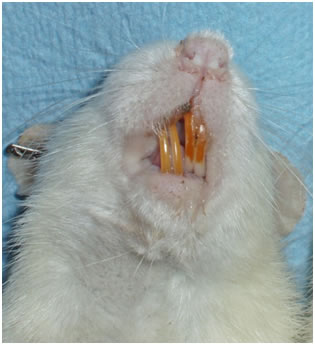
Malocclusion in hamsters looks like the image above. The example above is from a rat rather than a hamster but malocclusion can occur in both species and looks very similar.
6. Overgrown teeth may need to be clipped
If your hamster’s teeth are not ground down properly they might grow too long. According to the Merck Vet Manual, this can result in the following symptoms:
- Drooling
- Loss of appetite
- Weight loss
Overgrown incisors are easy to spot because they usually begin to curve and stick out between the lips.
When this happens, it’s important to take them to a vet so that their teeth can get clipped. This is necessary because otherwise, it can make eating almost impossible for your hamster. In addition, their incisors can even grow into the roof of their mouth, causing injury.
7. You do not need to brush your hamster’s teeth
Some hamster owners wonder if they should brush their hamster’s teeth. Luckily, this is not necessary. The best way to keep your hamster’s teeth clean is not by brushing, but instead by giving them a good diet.
About 80% to 90% of their daily food intake should come from commercial pellets or from seeds, with the remaining 10 to 20% consisting of fresh fruits and vegetables and the occasional treat such as meat, fish, or nuts.
In addition, chew toys are also very important in keeping your hamster’s teeth clean. They do not only help to grind down their teeth, but they also remove any food remains that might be stuck in between them.
8. Hamsters need regular tooth checkups
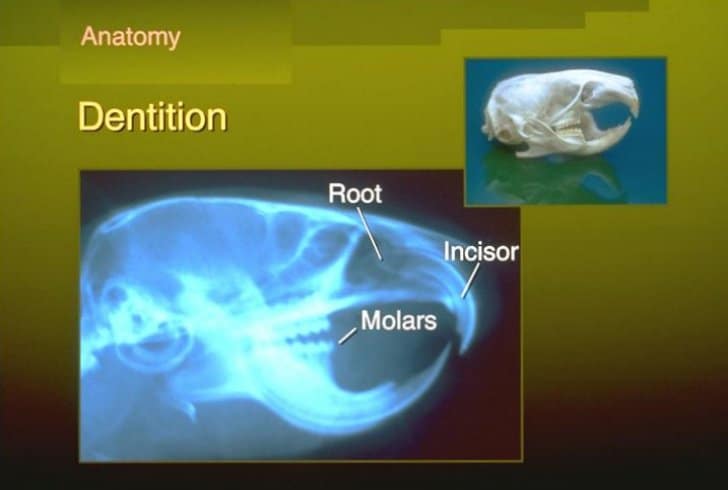
Just like we go to the dentists regularly, hamsters need the same. In the case of hamsters, it’s even more important because they cannot talk and let us know when they’re feeling pain in their teeth.
Hamsters are prey animals, because of that, they often hide their symptoms until they’re very sick. Because of that, PetMD recommends that you take your hamster for a check-up to the vet at least once a year, who should then check their teeth.
9. Hamsters sometimes chatter their teeth
If you’re a hamster owner you might’ve heard them chattering their teeth. They do this for a variety of different reasons, here are the most common ones:
- Annoyance. If your hamster is annoyed, they often start chattering. They typically use this sound as a warning sound before they’re about to bite. If they make this noise, it’s best to leave them alone for a bit.
- Apprehension. Hamsters often make this noise in the wild to warn others to stay away from their territory.
- Hunger. Sometimes your hamster might chatter just because they’re hungry. Try giving them a bit of food to see if it helps.
- How Long Do American Eskimo Dogs Live? Important Factors and Care Tips - September 29, 2023
- Do American Bulldogs Need Grooming? Essential Tips and Care Guidelines - September 29, 2023
- Do Bengal Cats Enjoy Playing? Essential Tips for Keeping Them Active - September 29, 2023